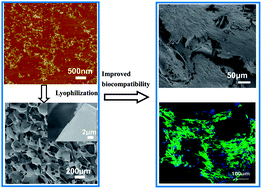Nanoscale control of silks for nanofibrous scaffold formation with an improved porous structure†
Abstract
Silk-based porous scaffolds have been used extensively in tissue engineering because of their excellent biocompatibility, tunable biodegradability and robust mechanical properties. Although many silk-based scaffolds have been prepared through freeze-drying, effective control of porous structures during this process still remains a challenge. In the present study silk fibroin scaffolds with different nanostructures were self-assembled in aqueous solution by a repeated drying–dissolving process and then used to improve porous structure formation in the lyophilization process. Viscosity, secondary structures and water interactions were also studied to exclude their influence on the formation and control of porous structures. Following nanofiber formation in aqueous solution, silk scaffolds with an improved porous structure were directly formed after lyophilization and then stabilized with water or methanol annealing treatment. Compared to silk scaffolds derived from fresh solution, the nanofibrous scaffolds showed significantly better cell compatibility in vitro. Therefore, this nanoscale control of silk offers a feasible way to regulate the matrix features including the porous structure and nanostructure, which are important in regulating cell and tissue outcomes in tissue engineering and regeneration, and then achieve silk-based scaffolds with improved properties.

- This article is part of the themed collection: Emerging Investigators

 Please wait while we load your content...
Please wait while we load your content...